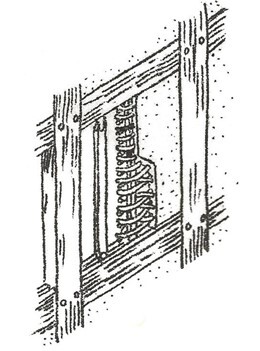|
The following article was originally published in Volume 1 of the Longridge & District Local History Society Review, 1974.
During 1973 Mr. Harry Newsham of Crumpax Farm was making internal alterations to his house. When demolishing a wall he discovered a magnificent section of wattle & daub walling. As Crumpax is the oldest house in Longridge, being built at the end of the sixteenth century, it was not surprising to find wattle & daub, but it was interesting to find this type of walling in such excellent condition. Although found only as internal walling at Crumpax wattle & daub was in general use as external walling also. In this type of construction a wooden frame consisting of vertical and horizontal studs (usually oak) was built first. Between the horizontal studs oak staves were sprung into slots. Hazel wattles were then woven in and out of the oak staves. The daub - a mixture of clay, straw and horse hair was then pressed between the wattles. The daub on both sides was then finished with a thin plaster coating. On external walls the plaster coating rendered the material water proof. Frequently the studs were coated with pitch and the plaster was white washed. This gave the spectacular black and white effect which is still admired. The diagram shows the horizontal and vertical oak studs secured by oak pegs. The top of each horizontal stud is grooved. The battes of the stud contains a series of holes. Each oak stave is pointed at the top and chisel shaped at the bottom. The top pointed end is fitted into a hole in the stud. The bottom end is then sprung into the groove. Although the Crumpax wattles are hazel it must be pointed out that willow withies were also very commonly used. We are most grateful to Mr. Newsham for drawing our attention to this piece of Longridge history. |
|
The following article was originally published in Volume 1 of the Longridge & District Local History Society Review, 1974.
During 1973 Mr. Harry Newsham of Crumpax Farm was making internal alterations to his house. When demolishing a wall he discovered a magnificent section of wattle & daub walling. As Crumpax is the oldest house in Longridge, being built at the end of the sixteenth century, it was not surprising to find wattle & daub, but it was interesting to find this type of walling in such excellent condition. Although found only as internal walling at Crumpax wattle & daub was in general use as external walling also. In this type of construction a wooden frame consisting of vertical and horizontal studs (usually oak) was built first. Between the horizontal studs oak staves were sprung into slots. Hazel wattles were then woven in and out of the oak staves. The daub - a mixture of clay, straw and horse hair was then pressed between the wattles. The daub on both sides was then finished with a thin plaster coating. On external walls the plaster coating rendered the material water proof. Frequently the studs were coated with pitch and the plaster was white washed. This gave the spectacular black and white effect which is still admired. The diagram shows the horizontal and vertical oak studs secured by oak pegs. The top of each horizontal stud is grooved. The battes of the stud contains a series of holes. Each oak stave is pointed at the top and chisel shaped at the bottom. The top pointed end is fitted into a hole in the stud. The bottom end is then sprung into the groove. Although the Crumpax wattles are hazel it must be pointed out that willow withies were also very commonly used. We are most grateful to Mr. Newsham for drawing our attention to this piece of Longridge history. |

